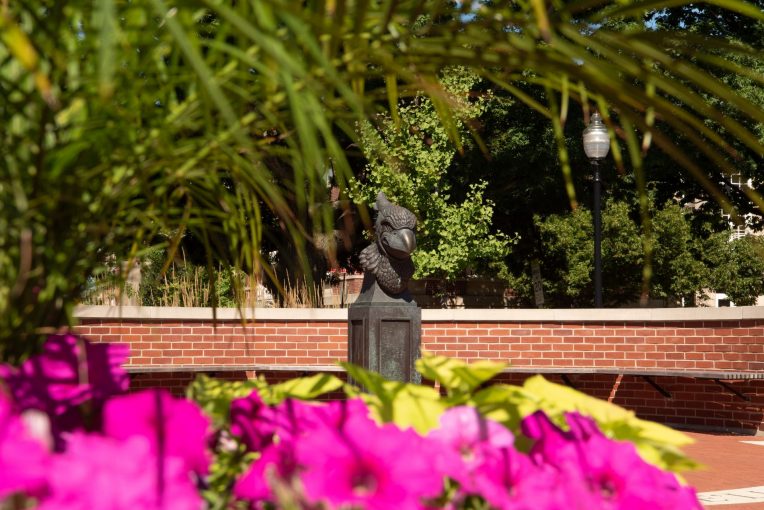Several faculty and student volunteers in the School of Information Technology (IT) collaborated with industry professionals to host this year’s high school cybersecurity defense competition, a collaborative event that benefits all participants involved.
As the field of cybersecurity continues to grow, cyber defense competitions are becoming increasingly more common. The National Collegiate Cyber Defense Competition is well known at the collegiate level, which is similar to the Central Illinois High School Cyber Defense Competition (CIHSCDC), hosted annually by Illinois State University.
“Events like the CIHSCDC are incredibly beneficial for IT students because it gives us the chance to take what we’ve learned in the classroom and not only apply it, but teach it to others,” said Casey Johnson, a senior cybersecurity major who helped organize the event. “For me, I think this is the coolest benefit of the CIHSCDC. Not only does it benefit the community as it continues to teach high school students about cybersecurity, but it gives the opportunity to our very own cybersecurity students to apply the knowledge that they’ve gained at ISU.”
How it works:
The CIHSCDC is broken down into three competing teams: Red, Blue, and White.
The Blue team consists of different groups of high school students who compete against each other to earn the most amount of points at the end of the day. Each Blue team group is responsible for putting up cybersecurity measures (like updating vulnerable software, configuring their firewall, and changing default passwords) while also solving a series of puzzles and tasks randomly presented to them throughout the competition. This year, seven high school groups competed in the competition, some being introduced to the experience for the first time.
The Red team acts as the offense and consists of information security professionals from Illinois State’s Information Security Office, State Farm Pen Testers, and Illinois State cybersecurity students. They are responsible for infiltrating the Blue team’s machines and are beneficial in sharing their expertise and valuable feedback as working professionals in the field.
The White team is comprised of Illinois State IT students, who observe the competition, offer their assistance, and answer questions to help the members of the Blue Team.
Organizing a successful event:
This was not Illinois State’s first time hosting the competition, but it was the first time it was presented in a virtual format—the greatest challenge organizers faced when putting the event together.
Dr. Sumesh Philip, an associate professor in the School of IT, was tasked with transitioning the competition to a virtual space and worked with other faculty and student volunteers in the school, along with admins from the CAST’s IT department.
“While the greatest challenge of organizing the event this year was moving it to a virtual format, working with all of the faculty and students to make the competition a success was a wonderful experience,” said Philip.
Johnson also agrees that the virtual component was a challenge, while the collaborative component was a reward.
“Facilitating the competition for the first time virtually was the largest challenge we faced. We had to pick a platform that not only allowed the students to talk to each other throughout the competition, but also allowed Blue Team, Red Team, and White Team members to talk to each other seamlessly,” she said. “Discord is mainly a platform used for online gaming, but it provided us all the functionality we needed to facilitate the CIHSCDC for the first time virtually. Our main goal was to still make this competition a collaborative, team building, learning experience for Blue Team members, and the platform, Discord, was a huge help in making that goal a reality for the competition.”
Despite any challenges faced in organizing the competition, Philip is happy with the successful outcome.
“Hearing all of the positive feedback and watching everyone have fun while learning made this such a positive experience,” he said. “At the end of the day, the participating students get to see what the field is all about, hopefully become more curious about a degree in cybersecurity, and maybe even develop some interest in pursuing a degree at ISU.”
Volunteering to help organize this year’s competition was bittersweet for Johnson, who reflected on her participation throughout her time here at Illinois State.
“I remember volunteering for this event as a sophomore who was questioning if cybersecurity was the right fit for me. It was so empowering as a volunteer to be able to sit side-by-side and learn with these high school students who were so excited to be on campus and to participate in the competition,” she said. “There is a lot of talk nowadays about how much has changed in the past couple of years, but for me, this event brings out how much I’ve been able to grow over the past couple of years. Encapsulated within this event is the transformation of an overwhelmed and confused sophomore cybersecurity student to a (almost) graduated cybersecurity professional on the cusp of starting her fulltime job at State Farm.
“I hope this highlights how important events like this are for students. I think the importance between having a continuous balance between learning in the classroom and experiencing the material in real-life situations is sometimes lost for students. Events like the CIHSCDC are necessary for students to reconnect with their passion outside of the classroom.”
Want to learn more about a major in cybersecurity at Illinois State? Visit the School of Information Technology’s website here.

